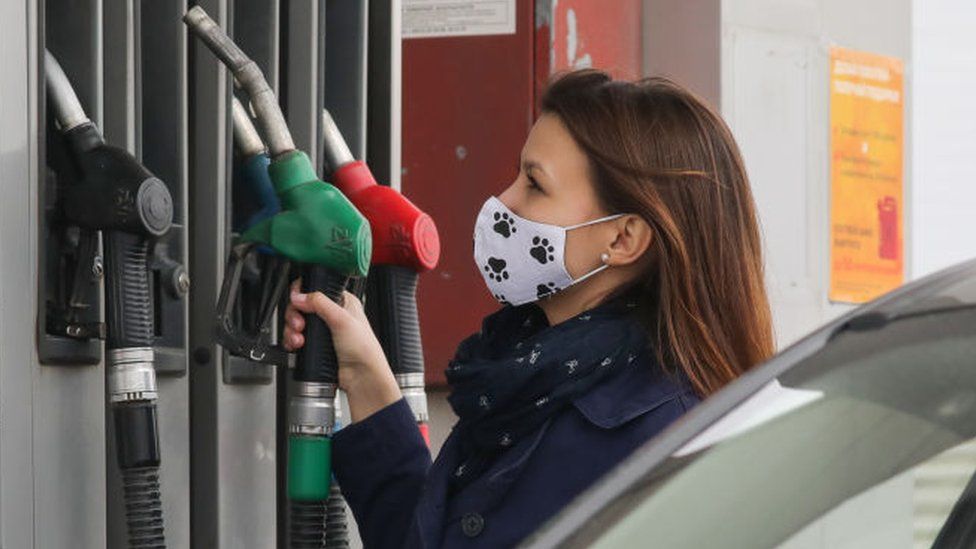
Getty Images
A more eco-friendly petrol is coming to British filling stations this month, but a quarter of drivers do not know whether their cars can run it, new research says.
The government intends to make E10 the new standard petrol grade.
It contains less carbon than other fuels and more ethanol, a kind of alcohol manufactured from plants.
But according to the RAC, 24% of motorists are unaware of it, while 27% do not know if their car is compatible.
Current petrol grades in the UK – known as E5 – contain up to 5% ethanol, with the other 95% being regular unleaded petrol.
Their replacement, E10, will see this percentage increased to 10% – a proportion that would bring the UK in line with countries such as Belgium, Finland, France and Germany.
Introducing E10 could cut carbon emissions by 750,000 tonnes a year, says the Department for Transport, the equivalent of taking 350,000 cars off the road and an important step towards the government’s climate change targets.
The new fuel is being rolled out everywhere in the UK except Northern Ireland, where it is not due to arrive until early 2022.
Every petrol vehicle built after 2011 should accept E10. But it will not be compatible with some older vehicles – as many as 600,000 of those currently on UK roads, the RAC estimates.
The government has set up a website where drivers can check whether their car will run on E10 fuel.
But it warns it will not be liable for any damage to vehicles as a result of drivers using its checker – especially if their car has been fitted with replacement parts.
The RAC said 26% of drivers surveyed had already checked online, with a further 15% saying they had found their car was compatible by another means.
Those with incompatible vehicles will have to use E5 super unleaded instead, which the RAC says can cost 12p a litre more than standard unleaded.
According to its survey, 59% of drivers who know their cars are incompatible with E10 are worried about the higher cost of filling up, while 20% fear mistakenly filling their tanks with E10.
RAC head of policy Nicholas Lyes said E10 petrol had already started appearing on forecourts to replace the old E5 blend and the process would continue “at pace” in coming weeks.
He said that while it would make no difference to “the vast majority” of petrol car drivers, a “sizeable minority” would be adversely affected.
“Drivers who will continue to rely on E5 will also need to make sure the filling station they’re visiting stocks the fuel in the first place, or risk running out of fuel and having to call on their breakdown provider,” he added.
“We’d also like to remind owners of classic cars that need to be careful not to accidentally top up with E10 and then leave it sat unused in the tank for long periods, something which can lead to expensive damaged plastics, metals and seals.”
In another development, oil giant Shell announced on Wednesday it was aiming to install 50,000 charging points on Britain’s streets by 2025, as part of a government-backed push to increase electric vehicle numbers and reduce carbon emissions to net zero by 2050.
Shell will roll out the charging points through on-street charging point company Ubitricity, which it acquired in February.
The government has estimated that the UK will need between 280,000 and 480,000 charging points by 2030, the year it plans to ban the sale of new petrol and diesel cars.

ivermectin otc – ivermectin usa order carbamazepine 200mg without prescription
cheap amoxil – buy amoxicillin tablets order ipratropium pill
buy zithromax 250mg pill – cheap bystolic 5mg oral nebivolol 5mg
order neurontin online – gabapentin canada buy itraconazole sale
furosemide over the counter – buy furosemide sale diuretic betnovate 20 gm us
buy monodox without prescription – order ventolin 2mg pill glipizide tablet
buy augmentin 625mg online – order ketoconazole without prescription oral duloxetine 20mg
rybelsus 14mg pill – buy generic levitra for sale order cyproheptadine online
tizanidine 2mg generic – hydrochlorothiazide buy online order microzide 25mg generic
buy cialis sale – sildenafil online order sildenafil india
order sildenafil online – order viagra for sale cialis tadalafil 40mg
cenforce oral – cheap chloroquine 250mg buy glycomet 1000mg pills
buy omeprazole 20mg without prescription – lopressor 50mg pill order generic tenormin 50mg
methylprednisolone 8 mg without prescription – lyrica online buy aristocort 4mg ca
order desloratadine 5mg without prescription – buy clarinex pill dapoxetine 30mg brand
cytotec price – buy diltiazem 180mg generic diltiazem 180mg uk
acyclovir uk – order rosuvastatin 10mg online buy rosuvastatin generic